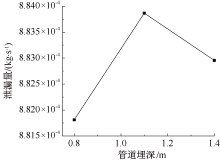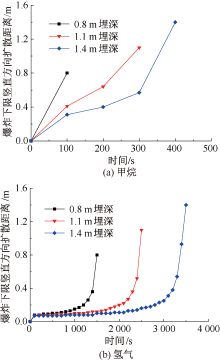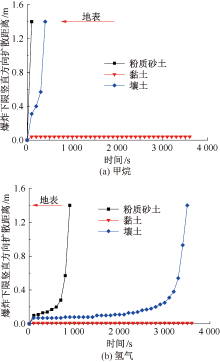| [1] |
李承明. 氢能改变未来[J]. 西部大开发, 2019(7): 40-43.
|
| [2] |
徐东, 刘岩, 李志勇, 等. 氢能开发利用经济性研究综述[J]. 油气与新能源, 2021, 33(2):50-56.
|
|
XU Dong, LIU Yan, LI Zhiyong, et al. A cost-efficiency review of hydrogen energy exploitation[J]. Petroleum and New Energy, 2021, 33(2):50-56.
|
| [3] |
尚娟, 鲁仰辉, 郑津洋, 等. 掺氢天然气管道输送研究进展和挑战[J]. 化工进展, 2021, 40(10):5499-5505.
doi: 10.16085/j.issn.1000-6613.2020-2140
|
|
SHANG Juan, LU Yanghui, ZHENG Jinyang, et al. Research status-in-situ and key challenges in pipeline transportation of hydrogen-natural gas mixtures[J]. Chemical Industry and Engineering Progress, 2021, 40(10):5499-5505.
doi: 10.16085/j.issn.1000-6613.2020-2140
|
| [4] |
李敬法, 苏越, 张衡, 等. 掺氢天然气管道输送研究进展[J]. 天然气工业, 2021, 41(4):137-152.
|
|
LI Jingfa, SU Yue, ZHANG Heng, et al. Research progresses on pipeline transportation of hydrogen-blended natural gas[J]. Natural Gas Industry, 2021, 41(4):137-152.
|
| [5] |
任泽乾. 天然气管道泄漏危害研究[D]. 抚顺: 辽宁石油化工大学, 2019.
|
|
REN Zeqian. Research on leakage hazard of natural gas pipeline[D]. Fushun: Liaoning Petrochemical University, 2019.
|
| [6] |
谢萍, 伍奕, 李长俊, 等. 混氢天然气管道输送技术研究进展[J]. 油气储运, 2021, 40(4):361-370.
|
|
XIE Ping, WU Yi, LI Changjun, et al. Research progress on pipeline transportation technology of hydrogen-mixed natural gas[J]. Oil & Gas Storage and Transportation, 2021, 40(4):361-370.
|
| [7] |
WILKENING H, BARALDI D. CFD modelling of accidental hydrogen release from pipelines[J]. International Journal of Hydrogen Energy, 2007, 32(13):2206-2215.
doi: 10.1016/j.ijhydene.2007.04.022
|
| [8] |
LOWESMITH B J, HANKINSON G, SPATARU C, et al. Gas build-up in a domestic property following releases of methane/hydrogen mixtures[J]. International Journal of Hydrogen Energy, 2009, 34(14):5932-5939.
doi: 10.1016/j.ijhydene.2009.01.060
|
| [9] |
MARANGON A, CARCASSI M. Hydrogen-methane mixtures: dispersion and stratification studies[J]. International Journal of Hydrogen Energy, 2014, 39(11):6160-6168.
doi: 10.1016/j.ijhydene.2013.10.159
|
| [10] |
SUBANI N, AMIN N, AGAIE B G. Hydrogen-natural gas mixture leak detection using reduced order modelling[J]. Applied and Computational Mathematics, 2015, 4(3):135-144.
doi: 10.11648/j.acm.20150403.16
|
| [11] |
贾文龙, 温川贤, 杨明, 等. 掺氢天然气输送管道阀室泄漏扩散规律研究[J]. 油气与新能源, 2021, 33(5):75-82.
|
|
JIA Wenlong, WEN Chuanxian, YANG Ming, et al. Study on leakage and diffusion of hydrogen mixed natural gas in the valve chamber[J]. Petroleum and New Energy, 2021, 33(5):75-82.
|
| [12] |
SU Yue, LI Jingfa, YU Bo, et al. Numerical investigation on the leakage and diffusion characteristics of hydrogen-blended natural gas in a domestic kitchen[J]. Renewable Energy, 2022, 189:899-916.
doi: 10.1016/j.renene.2022.03.038
|
| [13] |
孙齐, 李凤, 王一玮, 等. 掺氢天然气管道泄漏扩散规律及监测探头布设方案[J]. 油气储运, 2022, 41(8):916-923.
|
|
SUN Qi, LI Feng, WANG Yiwei, et al. Leakage and diffusion of hydrogen-mixed natural gas pipeline and layout plan of detectors[J]. Oil & Gas Storage and Transportation, 2022, 41(8):916-923.
|
| [14] |
常欢, 谭羽非, 王雪梅, 等. 城市直埋燃气管道泄漏沿土壤扩散模拟研究[J]. 煤气与热力, 2020, 40(11):28-34.
|
|
CHANG Huan, TAN Yufei, WANG Xuemei, et al. Simulation study on leakage diffusion of urban directly buried gas pipeline along soil[J]. Gas & Heat, 2020, 40(11):28-34.
|
| [15] |
何乐平, 唐爽, 胡启军, 等. 综合管廊天然气泄漏扩散及监控方法优化研究[J]. 中国安全科学学报, 2019, 29(9):43-50.
doi: 10.16265/j.cnki.issn1003-3033.2019.09.007
|
|
HE Leping, TANG Shuang, HU Qijun, et al. Study on natural gas leakage and diffusion in utility tunnels and optimization of monitoring methods[J]. China Safety Science Journal, 2019, 29(9):43-50.
doi: 10.16265/j.cnki.issn1003-3033.2019.09.007
|
| [16] |
李明高, 李明. ANSYS 13.0流场分析技术及应用实例[M]. 北京: 机械工业出版社, 2012: 8-12.
|
| [17] |
王向阳, 杜美萍, 汪彤, 等. 埋地燃气管道泄漏扩散过程数值模拟[J]. 中国安全科学学报, 2018, 28(2):45-50.
|
|
WANG Xiangyang, DU Meiping, WANG Tong, et al. Numerical simulation of leakage of gas from buried pipeline and its diffusion process[J]. China Safety Science Journal, 2018, 28(2):45-50.
|
| [18] |
徐丹. 天然气管道泄漏的数值模拟研究[D]. 淮南: 安徽理工大学, 2019.
|
|
XU Dan. Numerical simulation of natural gas pipeline leakage[D]. Huainan: Anhui University of Science and Technology, 2019.
|
| [19] |
周苗. 埋地燃气管道在土壤中的泄漏扩散模拟[D]. 济南: 山东建筑大学, 2018.
|
|
ZHOU Miao. Diffusion simulation of buried gas pipeline in soil[D]. Ji'nan: Shandong Jianzhu University, 2018.
|
| [20] |
LI Minghao, CHEN Shuangqing, JIANG Weidong, et al. Numerical simulation analysis of the hydrogen-blended natural gas leakage and ventilation processes in a domestic house[J]. ACS Omega, 2023, 8(38):34610-34 628.
|
| [21] |
蒋永清, 任喆, 孙超, 等. 埋地管道泄漏天然气在分层填筑土壤扩散数值模拟研究[J]. 中国安全生产科学技术, 2016, 12(6):105-109.
|
|
JIANG Yongqing, REN Zhe, SUN Chao, et al. Numerical simulation research on diffusion of natural gas leaking from buried pipeline in layered filling soil[J]. Journal of Safety Science and Technology, 2016, 12(6):105-109.
|























